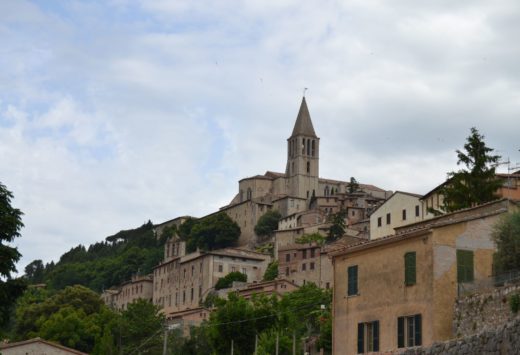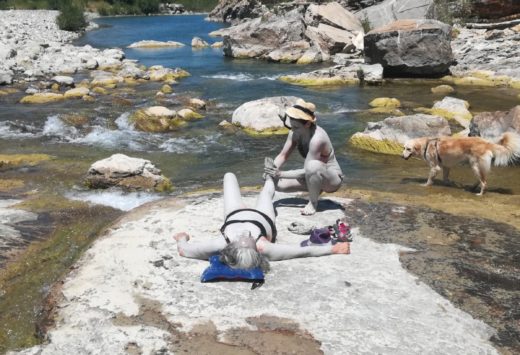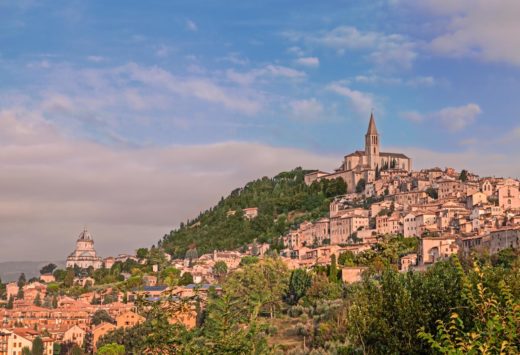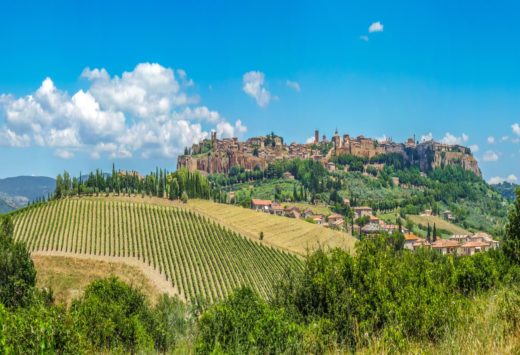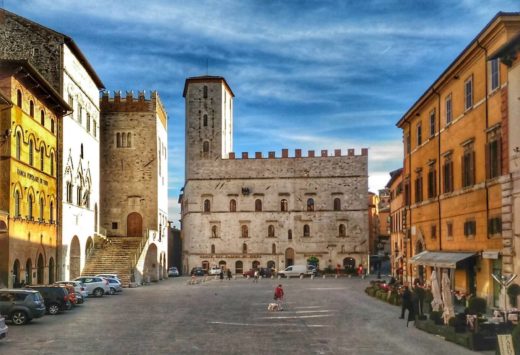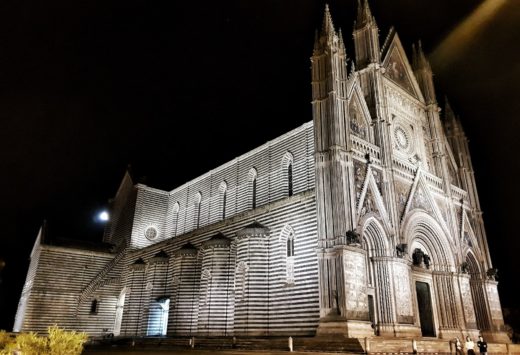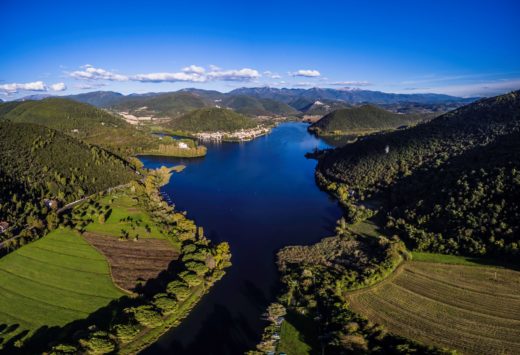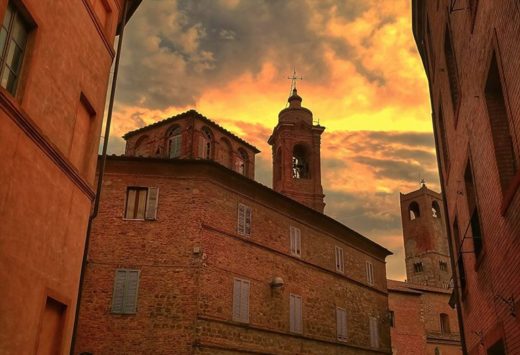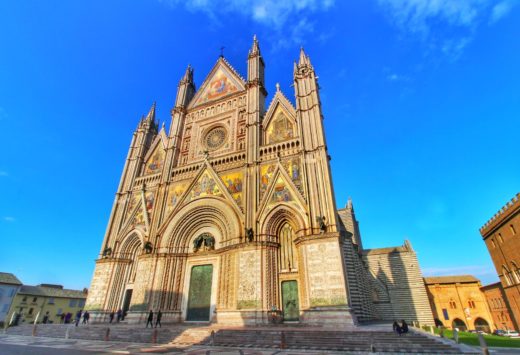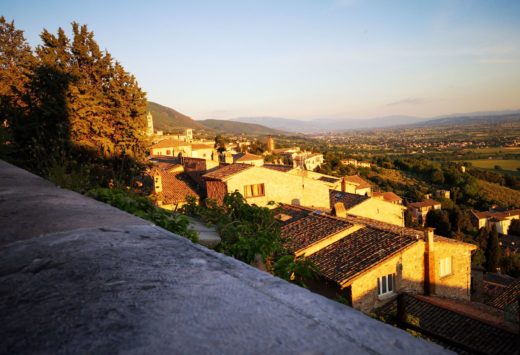FROM ITS ORIGINS TO THE MIDDLE AGES
The origins of Orvieto go back to time immemorial, to the 9th century BC, when traces of the first Villanovan community (earliest Iron Age) appeared on the large tuff cliff. They were the ancestors of the Etruscans, who became the undisputed masters of Central Italy for about six centuries. The city of Velza (Volsinii for the Romans, now Orvieto) was the seat of the league of the twelve main cities. Even before the great Roman Empire that dominated the Mediterranean, Orvieto was a cradle of culture and civilization. The city still preserves many vestiges of the prosperous Etruscan period, attesting to its glorious past: the Necropolises of Crocifisso del Tufo and della Cannicella, the Tempio del Belvedere, numerous ceramics and funerary objects displayed in the city museums, and the very recent archaeological site of Campo della Fiera, which many scholars identify as the famous Fanum Voltumnae. This would have been the seat of the league of the Etruscan cities where, according to ancient writers, the Council of Etruscan leaders periodically met to deliberate on domestic and foreign affairs and to elect the commander of the league. From the beginning, Velza, and therefore Orvieto, played an important role.
Due to internal disagreements, mainly caused by a slave revolt, some Etruscan noble families turned to the Romans for help. A small group of soldiers led by General Quintus Fabius Maximus was dispatched immediately but the uprising was so brutal that the general himself fell victim to the enemy, making the Roman backlash even harsher. In 264 BC, the great city of Velza was completely razed to the ground and its inhabitants forced to move near Bolsena, the Volsinii Novi of the Romans. A period of decadence and almost total abandonment of the tuff cliff ensued, and the affectionate inhabitants could not return until the 3rd century AD, during the deep crisis of the Roman Empire.
A slow process of repopulation of the city began with the barbarian invasions of the Goths and Lombards, starting from the western slope of the cliff, becoming the cradle of what would turn into the Urbs Vetus of the Middle Ages.
THE AGE OF THE COMMUNES AND THE RENAISSANCE
In 1137, Orvieto was established as a Free Commune, even if only a few years later, in 1157, a papal delegation formalized its investiture, placing control of the city in the hands of the Pope. The papal yoke, entrusted to various figures including Pietro Parenzo, transformed Orvieto into a Guelph stronghold in constant struggle with the Ghibelline factions of the city. The two noble local families who fought for power over decades were the Monaldeschi – Guelphs – and the Filippeschi – Ghibellines. Despite internal tensions, Papal protection guaranteed the city new cultural and social stimuli, ushering in a period of great development and prosperity for Orvieto. During the 13th century, the political structure of the city was consolidated, with the establishment of the most important Communal magistrates. The Fourth Lateran Council (1215), the figure of the Capitano del Popolo (1250) and the Magistratura dei Sette (1292) were established. At the same time the city changed in appearance, with the construction of important buildings and urban development which culminated with the opening of the Duomo construction site in 1290. In recent years, the city structure has reflected its excellent institutional organization. The four districts of the city: Serancia, San Giovenale, Postierla and Santa Pace became the seat of the powers recognized by the Commune via fair distribution: the Duomo became a symbol of religious power; the Palazzo del Popolo became an expression of popular sovereignty, and the Palazzo Comunale and the current Piazza della Repubblica became the seat of political power.
The prosperous period ended, unfortunately, in 1348, when due to the serious epidemic of plague that devastated Italy and the local noble families’ continuous internal struggles (four branches of the same family of the Monaldeschi were in conflict with each other), the city fell again and definitively under papal control. In 1354, Cardinal Egidio Albornoz led the pontiff’s troops to the city and began construction work on the Fortezza Albornoz, transforming the city of Orvieto into a veritable refuge for the popes after the invasion of Rome by the Landsknechte (mercenary soldiers). Undisputable proof of their presence is represented by the statues of Boniface VIII at the Maggiore and Soliana city gates and the construction of the two very famous wells of Cava and S. Patrizio, which were commissioned in 1527 by Pope Clement VII to ensure a water supply to the Fortress in case of siege.
However, as had already occurred in the 13th century, the papal presence in the 16th century also revived the city, fostering its architectural and cultural prosperity. It was during this period that figures such as Antonio da Sangallo, Ippolito Scalza and Francesco Mochi worked in the city, and the actors of the Confusi and Misti Academies operated, leading to the creation of the city’s theatre.
THE MODERN ERA
In 1798, the advent of French troops led to an uprising by the population of Orvieto, which was harshly and easily suppressed by the Napoleonic troops with the subsequent erection of the monument in Piazza Maggiore known as the Albero della Libertà.
A new period of prosperity for the city came only a few decades later, in 1860, with the annexation to the nascent Italian state, thanks to the heroic action of the native of Orvieto, Filippo Antonio Gualterio, who managed to put together an army of volunteers, the so-called ‘Cacciatori del Tevere’ (literally ‘Hunters of the Tiber’), who forced the papal troops to surrender.
From this moment on, Orvieto enjoyed yet another phase of prosperity and development. In fact, during this period the first water-powered funicular was built at the behest of the mayor Bracci, electricity was introduced – thanks to the construction of the modern power station built by the engineer Netti – the first real city theatre was erected, designed by the architect Vespignani, and work began on the ‘ Fondazione del Museo Faina’. The activity of private individuals, together with contributions from national and European Parliaments have led, since the 20th century, to the implementation of the ‘Progetto Orvieto’, an ambitious program to rediscover and enhance Orvieto’s history and monuments and foster the redevelopment of the city, which has now become an important national and international tourist attraction.


